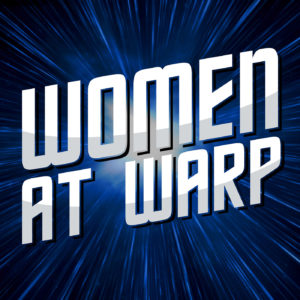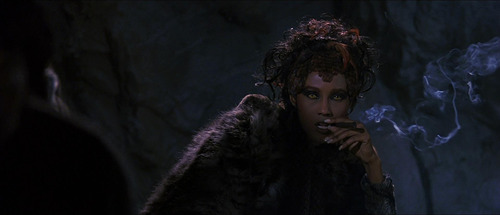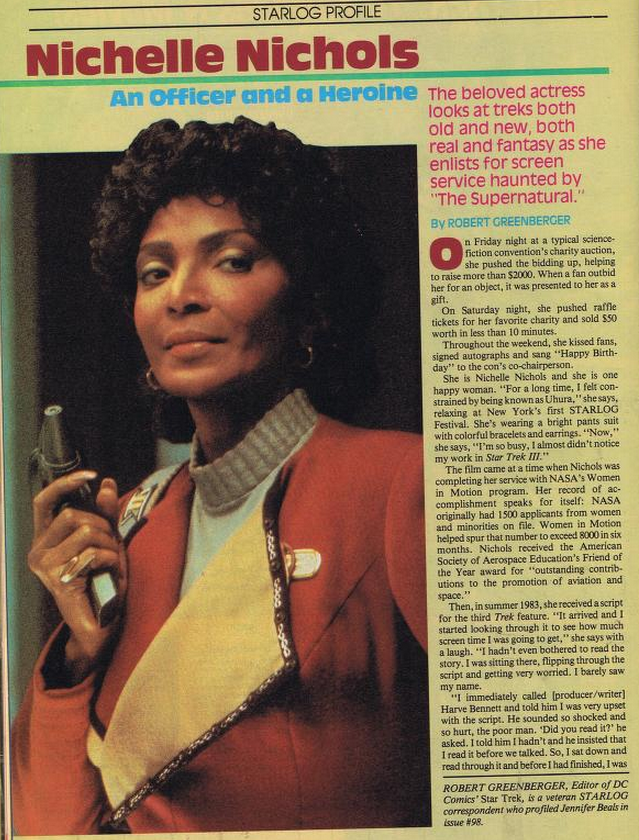The Valkyrie Directive and I are back again with another collaboration – inspired by Halloween, we thought it’d be fun to discuss the female villains of Star Trek, breaking down who they were and what role they played in their respective series/movies, comparing them to the male villains and questioning the common perceptions people had about them.
I hope you all enjoy reading it as much as we enjoyed making it, and feel free to join in in the comments!
TrekkieFeminist: I want to start by bringing in a quote from an article in the Mary Sue about Star Trek and women villains:
“Having female characters in films shouldn’t be about getting in a few nice, positive moments for women and then calling it a day. It should be about naturally having an equal distribution of genders in film roles.”
When we’re talking about women’s representation we don’t just want more women characters in stereotyped roles. We want women we can look up to as heroines (which Trek gives us) but that also show the range of possibilities for women, including the evil possibilities.

thevalkyriedirective: I love the Mary Sue, and I think it’s a brilliant and very relevant comment. I think Star Trek actually has more female villains than I was expecting it to. But of course, just as with their main female characters/heroes, there aren’t nearly enough compared to the men!
And I love that phrase “range of possibilities” – because I think that’s a problem all female characters suffer from: hero, villain or somewhere in-between, so often the women are lumped into stereotypical roles and end up being two-dimensional and boring because of it.

TrekkieFeminist: There are more women villains in Trek than I thought of initially too, but not enough. For example, consider that in all the classic Trek movies, I think Valeris is the closest we get to a woman villain. And sort of Martia the shapeshifter. Whereas for guys we have Khan, Chang, Sybok…
thevalkyriedirective: Oh yeah, the Trek movies are severely lacking in women villains! I think the only female villain in the Next Gen movies was the Borg Queen.
TrekkieFeminist: There’s also Lursa and B’Etor in Generations, but they were secondary villains, like the other women.
thevalkyriedirective: Oh of course, I’d forgotten about them. But they have the same problem that both Valeris and Martia have in Star Trek VI. In both movies the women are really just pawns in the schemes of men (General Chang in VI and Soren in Generations).
They’re still important, but out of all twelve movies the Borg Queen is the only main/primary villain that’s female.

Oh, and the way I’m defining main/primary villain is that they’re the one coming up with the scheme (kill Kirk, re-enter the Nexus, assimilate Earth), whereas the secondary villains are the ones who are pawns/carrying out the scheme.
TrekkieFeminist: Good point. So maybe let’s start by talking about the representations of women villains on Star Trek where we think they fell short or relied too heavily on stereotypes.
thevalkyriedirective: I think the best place to start for that is Seska
TrekkieFeminist: I think for me the one that bothers me the most is Seska.
thevalkyriedirective: AHAHA great minds think alike.
I had a discussion with someone (whoops, forgot who!) in the very early days of the Directive about Seska and the first big issue I have with her is that she has absolutely no logical motivation for doing what she’s doing. I mean what exactly is Seska’s goal? Why does she betray Voyager to the Kazon, who are no better than the thugs/biker gangs of the DQ?

TrekkieFeminist: That’s a great point. I’m not sure the writers really knew. Initially it seems to be bitterness over being forced to follow Janeway, but then it warps into this obsession with either manipulating or getting the attention of powerful men like Chakotay and Culluh.
thevalkyriedirective: Exactly, which just makes absolutely no sense to me, even from a “she’s a villain” POV! I can understand being bitter at Janeway’s decision to strand them in the DQ, but her solution for that is to… leave the ship and join a group of useless thugs?
TrekkieFeminist: It’s disappointing because it’s such an unfortunate stereotype about women: if you don’t return their love they just might go totally nuts and stalk you and try to trap you by getting themselves pregnant!
thevalkyriedirective: Hahaha, that’s exactly the way the writers went, and it’s just so bizarre. She turned into this crazy stalker trying to impregnate herself and it just had no rhyme or reason to it.
Whomever I was talking to about this equated her with a typical moustache-twirling villain and I think that’s an absolutely spot-on description.
TrekkieFeminist: It’s very much a “woman scorned” trope.
thevalkyriedirective: Definitely, except that she wasn’t really actually scorned. That’s why I think the entire character rang so untrue. She wasn’t even seeking revenge for something that had been done to her, she was just being nuts for the sake of being nuts…
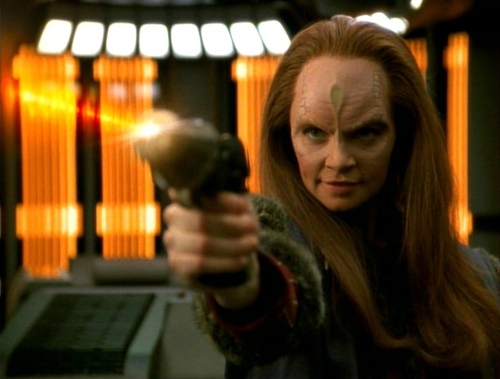
TrekkieFeminist: And then also the way Chakotay responds to it – stealing a shuttle to go off and see her the first time they find her, because he feels “responsible for her”. It’s very paternalistic. Dude, she’s an adult! She makes her own decisions.
thevalkyriedirective: Bleh, I’d forgotten about that. The entire relationship between them was just… poorly written.
TrekkieFeminist: It was also hard to buy because we never saw them being more intimate than Chakotay and B’Elanna. It made it difficult to believe that they had something there – they never laid the groundwork. But I guess we were supposed to buy it because it has elements of stereotypes we’re familiar with!
thevalkyriedirective: Exactly, we never saw them as a couple, so her revenge spree just made her seem crazy without any justification.
In my notes on Voyager I have some quotes from Martha Hackett (who plays Seska) on her character.
She says: “It just kinda evolved. They had no idea what direction Seska was gonna go in. It hadn’t been decided I think. With a new show, they’re trying things out and, with this show in particular, they had all these new enemy species and they were in a new quadrant that they had never gone before. I think they were just trying things on for size, so it wasn’t as if they were promising me this or that.”
And also: “When I first appeared on the show, Seska was just a member of the crew. It was only after I had done an episode that someone said, ‘We may be making you a spy’, but even then they weren’t sure.”
Now, I know that there are plenty of times when TV writers – and the Trek writers – made something up on the spot and had to retcon it in, or didn’t know where they were going (famously ending Season 3 of Next Gen, with “The Best of Both Worlds” and not knowing what was going to happen in Part 2!), but I find it really difficult to find a redeeming part of Seska’s character arc (not in terms of her redeeming herself, but as in, nothing about the storyline was any good). I don’t know if any aspect of it really worked for me… And that was even more disappointing because we’d had SO many fantastic Cardassian characters and villains!
thevalkyriedirective: Definitely not! I mean “I’m having your baby Chakotay”? That entire travesty of a storyline wouldn’t exist if it was a male villain and say, Janeway or B’Elanna.
TrekkieFeminist: Exactly, because it’s not seen as believable that a man could be that weak to go evil over being snubbed by a woman. It would’ve been more interesting if she turned out to be the ship serial killer instead of Suder! I think the more psychopathic emotionless villains are roles that we don’t often give to women. It’s implied women become villains often because of emotion. Or alternately, that they’re unable to be effective villains because of emotion.
thevalkyriedirective: That’s a brilliant point actually, AND perfect segue! Because I’d argue that both the Borg Queen and Female Founder were emotionless villains.
TrekkieFeminist: And I think two of the most complex, nuanced and just downright cool!
thevalkyriedirective: But I have to wonder if either of them were really female – one was Borg, and the other was a shapeshifter. Do either of those races HAVE gender? Both are really figureheads for a larger, malevolent force – the Borg and the Dominion.
But don’t get me wrong, I agree that they’re both brilliant and I am so, so pleased that women were chosen to play such fantastic characters.
TrekkieFeminist: I think they both present as female and we can consider them as such for this. On them being emotionless, I think they both also have a sense of superiority. I wonder if there’s a perceived connection that not having emotions or being able to subsume your emotions is necessary for that superiority.
thevalkyriedirective: That’s a brilliant point, and one that I think needs to be explored, because let’s think about this for a minute: why is it that we look at emotionless, powerful figureheads like the Borg Queen and the female Founder as brilliant female villains, but characters like Kai Winn or Sela aren’t often celebrated?
Most of the things I see about Winn in the DS9 tag are how much people loathe her, but I’m always baffled by that, because that’s the point of villains for me, you love to hate them! And I can’t help but wonder if its just that they too love to hate her, or if they genuinely hate hate her – and if the latter, why people loathe her but love Gul Dukat or Weyoun.
TrekkieFeminist: That’s a good question. I think Kai Winn is amazing. I love her and how creepy and earnest she is, but ultimately she also falls into that trap of her emotions being a liability. She’s heavily influenced by Dukat and deceived by him and then when she finds out who he really is, her emotional connection to him prevents her from getting out. It plays into that stereotype about women’s emotional weakness.
thevalkyriedirective: I’d argue that her downfall to the Pah Wraiths IS tied to Dukat for sure, but in the first six seasons she has her own agency and her own agenda, so we can’t discount that simply because the final push from ‘annoying power hungry and ambitious woman’ to ‘tool of the Pah Wraiths’ was Dukat.
TrekkieFeminist: I absolutely agree. I love how from her earliest appearances on the show she’s got such clear motives (unlike Seska). Her combination of piousness and ambition is villainous in a really unique way for Trek. Sometimes she’s merely irritating and other times she’s a significant threat. Sometimes she can be persuaded to put her hunger for power on the back-burner. Other times, not so much. She’s one of the few villains that’s not out there in another ship actually firing on our heroes, and I think that’s cool.
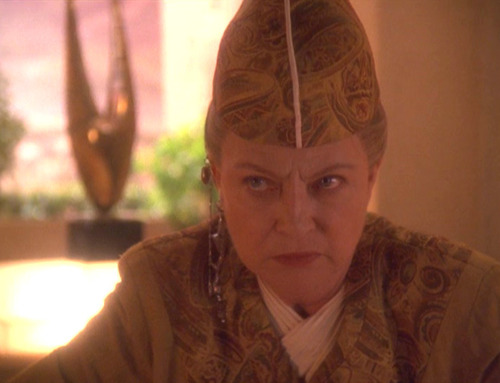
Curiously, I think Winn ultimately has more agency out of the two villains – after Dukat goes crazy in ‘Waltz’ he pits himself against Sisko as the Emissary. But Winn is still after the same thing she always was – power.
TrekkieFeminist: That’s a great point. Winn got so much more depth because she had those different relationships with different characters.
Let’s just go back to the Borg Queen for a second, I think the Borg Queen is one of the most powerful woman villains, which is cool.
In First Contact I think she falls more into a vamp/seductress role there, using her feminine wiles to seduce Data. But in Voyager that gets expanded in her almost maternal relationship with Seven and her antagonism to Janeway.
thevalkyriedirective: I definitely agree, they definitely played up her role as temptress/seductress in FC – though actually, I have to question this idea that just because a villain/character displays some slightly stereotypical aspect, we should dismiss them. After all, many of the male villains have their own stereotypes, usually involving being power hungry (General Chang) or seeking revenge (the most iconic of all, Khan). I’d argue that even in First Contact, the Borg Queen wasn’t just limited to seductress – even if I had wished they’d toned down that aspect somewhat.
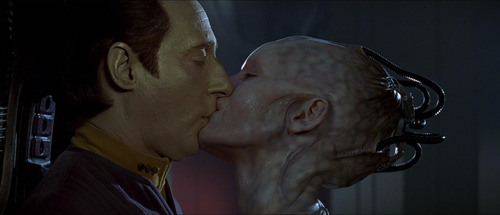
TrekkieFeminist: For sure. That’s not what I was trying to say. I think it’s ok to have stereotypes and tropes the audience can understand, but they should be deliberate and there should be a range of them. I think in FC the portrayal of the Borg Queen is helped because it’s clear how much of a threat she is. You can’t help but take her seriously.
thevalkyriedirective: And it also helped drive the plot, ultimately.
I think perhaps the main difference is quite simple: in FC she was pitted against men – Picard and Data to be precise, but in Voyager she was pitted against women – Janeway and Seven. And often, when you have male writers, they can’t seem to help but write female villains as wanting to seduce men, especially the heroes.
I’d like to talk more about the female Founder, because now that I think about it, she actually had the same role as the Borg Queen, in that she WAS a seductress trying to tempt Odo back into the Great Link. That was pretty much her entire arc at the start of Season 6, when the Dominion was in control of the station. She even said that her only reason for being there was to see Odo – and by “see Odo” she meant link with him and try to convince him to come home.

TrekkieFeminist: I like her relationship with Weyoun. She seems so bored of him at times but he’s so indispensible to her.
thevalkyriedirective: Yeah, I think that’s the difference between her and the Borg Queen. The Borg Queen didn’t have anyone to act against unless she was up against one of the heroes. But the Female Founder had Weyoun and (unless I’m misremembering) many scenes with Dukat and Damar and the Breen – she was really in charge of the Dominion’s War effort.
TrekkieFeminist: I’m not sure why they chose a female form for her. Odo was supposed to be imitating his “father”, Dr. Mora, but she chose that shape. Do you think it’s because we couldn’t imagine it being seductive to Odo for her to be androgynous or male?
thevalkyriedirective: I wonder about that too. There could have been a bit of homophobia to it. So while that aspect of it annoys me, I can’t help but be pleased because we did get a female villain out of it.
TrekkieFeminist: For sure, and even though her goals are very much about Odo, I think she’s really interesting and Salome Jens does a great job in that role.
thevalkyriedirective: I think they could definitely have explored more of the androgynous/genderless nature of the Founders and Odo.
TrekkieFeminist: Maybe Lwaxana could’ve got him exploring that potential!
thevalkyriedirective: I think the reason the female Founder works is because she has two goals. Her personal goal is to bring Odo into the Great Link. But her villain goal is to win the War for the Dominion – and we see her in that role just as much as we see her with Odo, maybe more towards the end of the show!
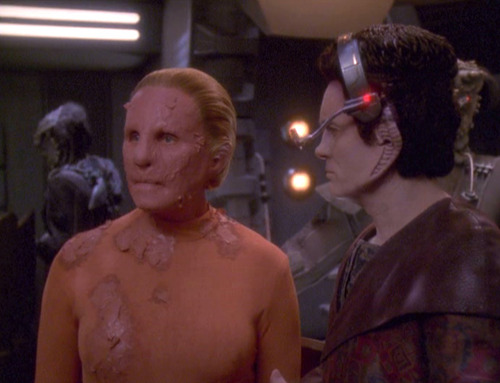
TrekkieFeminist: In the end the conflict between the goals contributes to her downfall, as she does things that aren’t so strategic in order to try to get Odo back on side, although partly it’s also being ruthless, which causes the resistance on Cardassia.
thevalkyriedirective: Just as the Borg Queen is the ruler of the Borg, the one who “brings order to chaos”, the female Founder is the individual in charge of the war effort – she’s the one Weyoun defers to, she’s literally worshipped as a God by him. I think that, despite both of them occasionally being seductresses, ultimately they’re both roles we rarely see women in.
TrekkieFeminist: Another great example of women villains breaking ground is the Duras sisters. I think Lursa and B’Etor are very much thuggish stereotypes, but that’s usually a stereotype we see reserved for men. It’s a break from the norm of what we get to see women villains usually do.
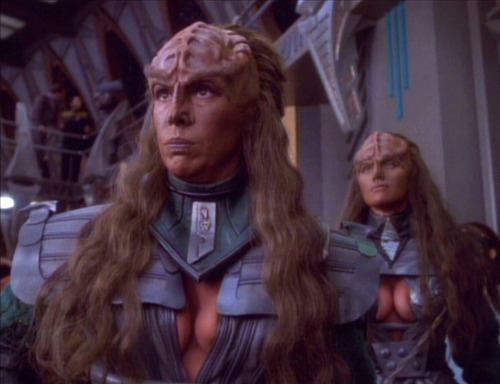
thevalkyriedirective: Yes! I absolutely adore them, not only are they female thugs, which we rarely see, but they’re sister thugs!
TrekkieFeminist: And they’re taken as a serious threat. Maybe a bit less so in Generations, where they abduct Geordi and install the spy thing in his VISOR. It’s one of those parts where you mostly just feel sorry for Geordi. But even though they’re the secondary villains in that movie, it’s significant that they were considered memorable enough to bring in to the movies from the regular series.
thevalkyriedirective: Oh yes, I’ve seen Generations and the episode of DS9 they were in recently. They were hilarious in Generations, they got a bit of comic relief, which was nice, talking about how repulsive human females were when Geordi woke up in Sickbay with Bev looking him over.
TrekkieFeminist: I think they were up there with Klingon villains like Chang because they were thugs but also super smart and manipulative.
thevalkyriedirective: Definitely – and they were brought back plenty of times before eventually being killed off, we can’t forget that.
TrekkieFeminist: Absolutely. Going back, one person I think is a bit hard to pin down is the Romulan Commander in “The Enterprise Incident”. I think that from today’s perspective she falls into the stereotype of a woman whose emotion (love for a man) is her ultimate downfall. But for the 1960s she’s pretty darn incredible. She’s in charge of a ship, she’s a formidable military commander and adversary for Kirk, and she even gets through a bit to Spock’s emotions. One of my favourite D.C. Fontana episodes for sure.
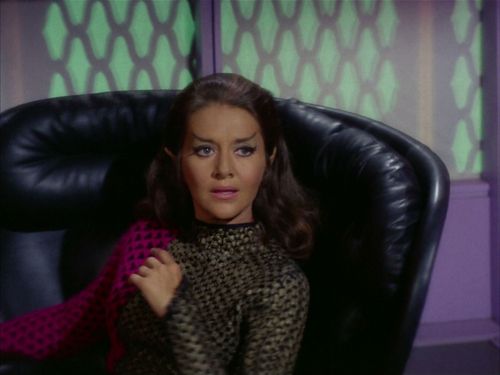
thevalkyriedirective: I’d argue that, ironically, TV shows in the 60s were more progressive than some of the stuff we see today. I mean, I can’t think of one recurring female villain on Enterprise. There was Silik, Shran, the Xindi leaders – all men (well, I think Xindi Aquatics were female actually, but every other sub-species were lead by men)!
TrekkieFeminist: I certainly haven’t seen one yet, but I’m just finishing Season 1.
thevalkyriedirective: Maybe there were minor roles or one-offs that were women that I’m forgetting, but certainly nothing on par with the other shows, even TOS!
TrekkieFeminist: Before I forget, there’s another big female Romulan villain we haven’t touched on yet: Sela.
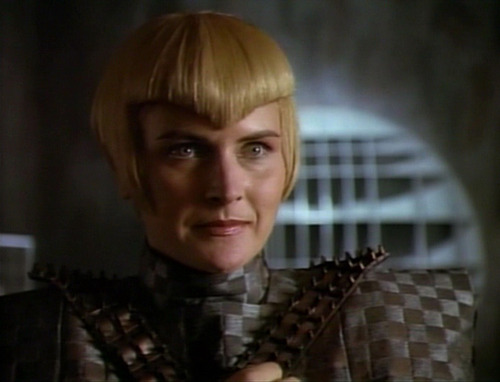
thevalkyriedirective: Oh, yes, it’s been a long time since I’ve seen her episodes either, so I’m going off memory here.
First of all, it was an awesome sci-fi way to bring Denise Crosby back into the series – and let her show off her acting chops. I also love that she was just as ruthless and manipulative and cunning as any other Romulan commander we’d met in Next Gen. She was seen as dangerous to both the Federation and sometimes to other Romulans – not someone to be dismissed at all.
TrekkieFeminist: It’s been a while for me too. I also just generally love the Romulans. Even from the Original Series they were written to be one of the most gender-neutral species, with men and women virtually interchangable. In The Making of Star Trek (1968) it says of The Romulans: “There is complete equality between the sexes; women are as often found in command of a ship as are men.” Oh! I forgot Sela kidnapped Geordi too! Poor Geordi.
thevalkyriedirective: Poor Geordi indeed, he gets kidnapped almost as much as Chief O’Brien!
I was wondering if we should try to look at the way female villains are seen compared to male villains? I’ve noticed that fans seem to adore Dukat and Weyoun in DS9, everyone loves Q, and Khan, of course. But I don’t see as much adoration for the female villains, and can’t help but wonder why that is.
TrekkieFeminist: I see that too, people love to hate the male villains but sometimes just hate the women villains. I think the Borg Queen is an exception. I rarely see that much negative about her.
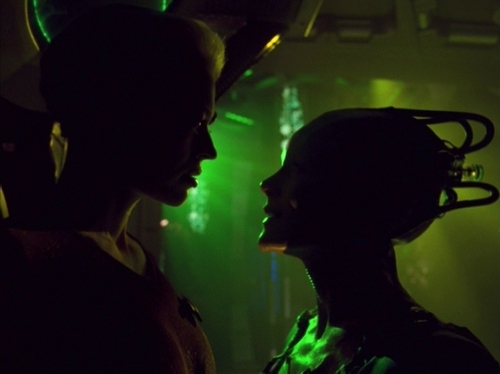
thevalkyriedirective: Do you think it’s part of the overall problem that people are more likely to dislike or hate female characters than male ones? Or that perhaps characters like Dukat, Weyoun, Q and Khan are all allowed to be more…charming, than their female counterparts.
TrekkieFeminist: It could be. It could also be the expectations on women to be likeable and conform to certain roles spilling over into the views of fans on the characters. I think when you have a writing team of mostly men, too, that they might be writing more and more well-rounded male villains.
thevalkyriedirective: I think that definitely comes into it – maybe it’s just my own, perhaps incorrect, perception that women villains aren’t as liked by fans as the men. Because I think many of the women we’ve talked about were quite well-rounded – more than I realised.
TrekkieFeminist: And I think what we talked about around emotion as strength vs. emotion as weakness plays in. For example, Khan is motivated by a desire for revenge. That’s emotional but it’s seen as somehow strong or admirable.
thevalkyriedirective: Definitely, I think perhaps Sela comes the closest to wanting revenge? I think her hatred of her Human features and her mother played into her hatred of the Federation, but I might be misremembering.
TrekkieFeminist: True, and I think she also has a significant fan following. It would be interesting to do some more digging through forums and message boards to get a better sense, but that was my impression.
thevalkyriedirective: Anyway, I think that was everything I wanted to cover…
TrekkieFeminist: Me too. I think to conclude I’d just say what I said that I was surprised how many villains we thought of and that there was a range of roles.
thevalkyriedirective: I think Trek actually does a surprisingly good job with its female villains.
TrekkieFeminist: If I had one piece of feedback for writers in the future it would be to try crafting a woman villain whose emotion is part of their strength, and overall just try to keep writing women in a range of villain roles.
thevalkyriedirective: I’m with you there, if there’s one thing Trek does well it’s give us a range of villains – I can only hope it starts channelling more of that in the Reboot!
